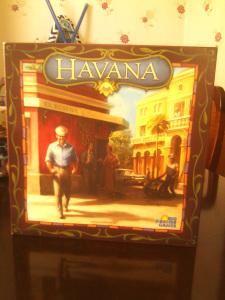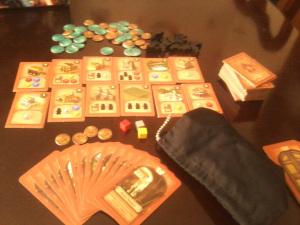
Havana is designed by Reinhard Staupe with artwork by Michael Menzel. The version I have is published by Rio Grande Games. It takes between 30-45 minutes to play and supports 2-4 players.
Say hello to the friendly Cuban walking up to greet you to Havana!

In this game you are attempting to build buildings to score victory points. The number of points you need to win changes depending on the number of players involved. As you can see in the picture there are two rows of six building tiles placed on the table. You have to buy from the outside in, and once there are two left in a row these are moved to the edge and four new buildings are taken from the stack and refresh the row. In the top right is a victory point value and at the bottom are the resources needed to build that building. You are able to build as many buildings as you can on your turn.
The resources are building materials, which are coloured cubes (red, yellow, brown and blue), debris (grey cubes) pesos and workers. At the beginning of the game four pesos are placed in the middle as are three random cubes. Each player will take a random cube from the bag and will also receive a peso. At any point on their turn a player is able to exchange five pieces of debris for a cube of their choice, and/or five pesos for a worker.
Each player has a hand of thirteen cards. These all have different actions and values ranging from 0-9. On the first turn players will place two cards, face down, on the table, then once all players have done this the cards are revealed. Each player orders his from lowest to highest, (for example, had I played a ’4′ and a ’1′ they would be arranged as ’1, 4′). The totals are looked at (in this case I have 14) and the player with the lowest total goes first, followed by the player with the next lowest and so on. Players perform the actions on the cards and then, if possible, build buildings. After all players have completed their turns three pesos are added to the middle and three random cubes are drawn from the bag. Then, the player who went first that turn plays a new card and discards one of the cards he has in play. In turn, everyone else follows and then reveals the new card, adjusted the order accordingly. The player with the lowest total goes first, and this continues until someone reaches the victory point goal.
I’ve been really impressed with Havana. I haven’t played the four player game yet but I have played it with three and two players. It’s surprisingly meaty for a short game and it offers a lot of tactical choices and decisions. I love the method of choosing which cards to play, as you have to assess what other players need and what they’re likely to play, as some cards are quite useless if someone else has played a similar card ahead of you. So you have to weigh up whether it’s better to go first or take a risk and hope that you won’t lose out if you go last. It gives you a lot to think about and I also love how you can only buy the tiles on the edge of the row, as this adds another layer to think about and plan for. It also helps to keep track of what cards your opponent has already played, so even when it’s not your turn you can be engaged, but really it’s not a long game and the turns come around quite quickly.
So far the vast majority of the games have been very close so there’s not a runaway leader problem. It’s quite easy for a player to build to or three buildings on one turn and catch up even if they are lagging behind. In one of the three player games I played it was possible for all three of us to win on the same turn and it just depended on who played the lowest total cards to allow them to go first. I wish more games implemented this system because so far it seems well-balanced and I don’t think I’ve seen anything like it in another game.
Unfortunately, the wealth of options available can lead to a form of analysis paralysis, especially as you have to weigh up what is best for you with what you think other players are going to do. However, this should be taken in the spirit of a light game and it’s not as though a two hour heavy game is going to depend on a decisions. If you do make an error then it’s very easy to set up and play again straight away. There are different strategies available as well, like are you going to hoard pesos, workers or resources, yet you also have to be careful to not make yourself a target for thieves and tax collectors.
Speaking of thieves and tax collectors, Havana does allow you to be a douche to the other players. There is also a card that allows you to remove one building from the edge, so if you know someone is hoping to build that building then you can totally screw them over. I quite like this because I can take it all in good spirits and again, it’s not like you’re ruining two hours of meticulous planning, but I know some people don’t like conflict so it may be an aspect of the game that people find unappealing. The good thing is that you don’t have to steal from people if you don’t want to, and there are ways to protect yourself from being stolen from.
I’m really enamoured with this game. It offers a lot to think about, a lot of options but it’s short enough that it doesn’t burn your brain too much and it can still be considered a light game. It’s also a good gateway game to teach people about resource management and thinking about how to anticipate other people. The artwork on the cards and tiles is nice as well. I was hoping that the bag was a little bigger so I could toss the box and keep everything in the bag to save space, but alas that was not to be. The rules were written well and it’s very easy to teach. The only thing that takes a little time for new players is to understand what all the cards do, but none of them are overly complicated and a new player can beat someone who has played it a lot (which I have found out, unfortunately). All the components are of a good quality and one little thing I like is that the backs of the cards have a picture of a door, so when you reveal them it’s as though you are opening the door to them.
Overall I really enjoy Havana and it hasn’t gotten old yet. There’s a lot of choices, it’s easy to get new people involved and it’s something that is accessible to people of various ages. It’s a relaxing, casual game that offers a lot of engagement and I would recommend it highly.
